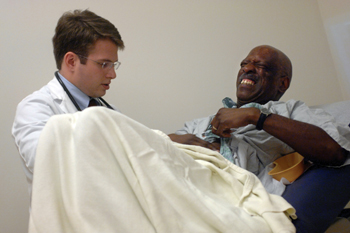
Third-year medical student Stephen Cook, left, examines a standardized
patient in the Center for Experiential Learning and Assessment (CELA).
Program gives med students feel for life in patient care trenches

Medical student Jill Richman gets her notes off the computer before examining a simulated patient. (photo by Dana Johnson)

Alan Johnstone, simulation technologist, mans the monitors in the control room at The Center for Experiential Learning and Assessment (CELA). (photo by Dana Johnson)

Makeup, or moulage, for incisions and other wounds is used on the simulated patients at CELA. (photo by Dana Johnson)
An African-American man in a hospital gown curls in a fetal position on an exam table. There's a knock on the door and a medical student enters the room. She introduces herself, pulls up a stool and lowers her face near the man's so she can hear his symptoms. Suddenly the man writhes in pain and shrieks at the top of his lungs. The student places a reassuring hand on his abdomen and starts the physical exam.
“You have eight minutes to complete your encounter,” a disembodied voice crackles over a ceiling speaker.
No, it's not 2 a.m. in Vanderbilt's Emergency Department — its Room 12 in the Center for Experiential Learning and Assessment (CELA), home of the School of Medicine's Program in Human Simulation. The man is an actor playing the role of a surgical patient with a perforated ulcer. Only the student is who she appears: third-year medical student Natalie Jacobowski.
Some 1,500 times during the academic year, Vanderbilt's Program in Human Simulation allows first- through fourth-year medical students to practice new skills on standardized patients — men and women paid to act out everything from schizophrenia to pancreatitis.
“The Program in Human Simulation is an extraordinary resource for Vanderbilt,” said John Shatzer, Ph.D., director of the Office of Teaching and Learning in Medicine. “It enables our students to learn and practice doctoring skills in a supportive and safe environment.”
Bonnie Miller, M.D., associate dean for Undergraduate Medical Education, says the program plays a major role in the Medical School's curricular reforms, which include an enhanced focus on communication skills, cultural competence and professionalism. “The program allows us to assess their progress and to evaluate the effectiveness of our own efforts,” Miller said.
Located on the fourth floor of MRB IV and directed by Lisa Rawn, the Program in Human Simulation is a marvel of technology. Twelve modern exam rooms are equipped with one-way observation mirrors, cameras and microphones that record each patient interaction.
Students have 15 minutes to complete a medical history and examination. Then they log patient notes and test orders into individual computers, where software captures the information for faculty assessment.
Faculty can videotape the encounter or monitor student-patient interactions from an observation room. They can instantly complete online assessments or enter comments into digitized video for students to review later.
After each encounter, the patient hops off the exam table and logs into a computer to rate the students on eight to 10 criteria, including hand washing and touching.
“We get feedback from the people watching us and from the standardized patients,” said third-year student Stephen Cook. During his surgery clerkship, Cook examined a woman with an infected incision created with stage makeup “It's really helpful. After you interview a real patient, you can't go back and say, 'I forgot to do something.'”
“I was surprised with CELA the first time I saw it,” said second-year student Thomas Spain, who experienced the program during the Physical Diagnosis class.
“I'd gotten used to things being well done at Vanderbilt, but I wasn't expecting CELA to be so well equipped. They did whatever was needed to make it the best it could be.”
The program also teaches the importance of a caring bedside manner, Spain said.
“It can be easy to become mechanical when you're learning technical skills and making sure you don't forget to ask important questions. The program teaches us not to ignore human warmth.
“Everyone is enjoying this aspect of our training,” Spain continued. “It's the first time we're applying what we've learned, and we're getting more face-to-face time than we would with real patients. I wish we could do more.”













